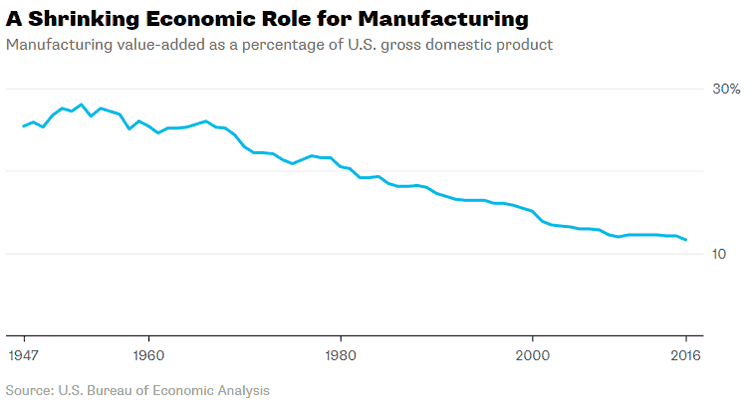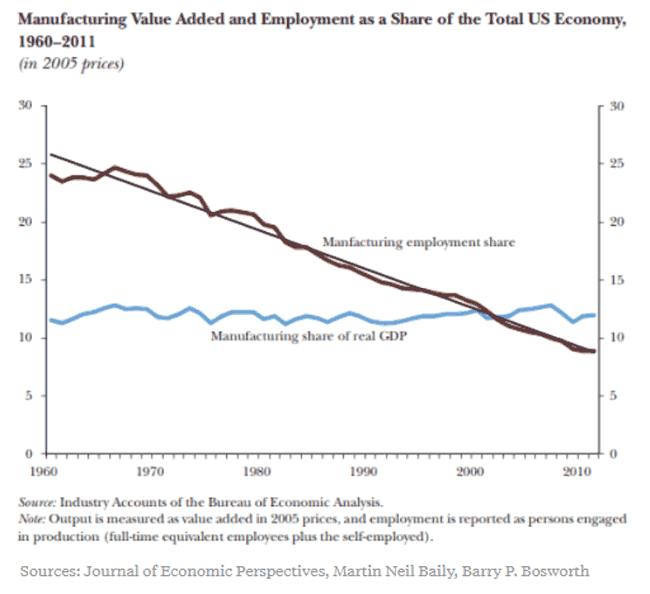We have been hearing it for years: the share of manufacturing in the overall US economy, as measured by gross domestic product or GDP, has been falling for decades, almost to the point of irrelevance.
Therefore, we need to get past any notion of reviving domestic production and get on with the realities of 21st century advanced economies.
Supply Chain Digest Says... |
|
|
And there is some truth to that view for sure. The chart below, part of a recent article on this topic by Justin Fox on Bloomberg.com, does in fact show a telling story on what has happened with US manufacturing as a share of the economy- by the most common measure.
As can be seen in the chart below, in 1960 manufacturing comprised roughly 28% of nominal GDP, falling steadily from there to about 20% by 1980 and now just about 12% in current times.
Whether that is good or bad is a matter of debate. Certainly, it appears that in general, the more advanced an economy is, the lower manufacturing’s share of GDP. Still, the sense that the US is losing its manufacturing capabilities in unsetting for many, while others point out that manufacturing still represents about 25% of export powerhouse Germany’s GDP.
There is, however, another way to look at the data, says Fox.
The chart below, he says, does not reflected changing relative prices. Because the prices of manufactured goods have gone up more slowly than those of other goods, Brookings Institution economists Martin Baily and Barry Bosworth argue that manufacturing's declining share of nominal GDP understates its true impact on the US economy.
In fact, the average annual increase in prices for US manufacturing goods since 1947 is only about 2.2%, versus 3.2% for the overall economy. Because the difference in price rises over time between that seen for manufactured products and other things we buy such as services is a huge reason why the share of US nominal (not inflation adjusted) GDP coming from manufacturing has fallen so steeply.

(Article Continued Below)
|
CATEGORY SPONSOR: SOFTEON |
|
|
| |
|
|
In other words, the share of manufacturing "units" produced relative to the overall economy shows a much brighter picture than does the view based on prices – which supply chain and other efficiencies have kept low. In fact, the share of US GDP relative to real GDP – taking out the effects of inflation – have stayed almost flat since 1947, at a little over 12% then, a bit under 12% today, as shown in another chart below from Baily and Bosworth:

However, it turns out trying calculate the impact of relative price changes over time is very tricky indeed, and many economists disagree with Baily and Bosworth’s calculations.
Responding to the criticisms, Baily - who was chief of the Council of Economic Advisers for the final year and a half of the Clinton administration - emailed the following to Fox:
"The share of nominal value added created in manufacturing has declined steadily. Because the relative price of manufactured goods has declined, the real value added share has not declined in the same way. That was the basic story we wanted to tell, and holds up. Saying the real share is constant may be an overstatement."
He added: "Close to the base year, the comparison of real value added is fine. As you get away from the base year, the calculation goes off, as you point out. I am not sure there is a good way to remedy that problem."
Fox also notes that a lot of recent growth in US manufacturing output can be explained by the arcane way that increasing capabilities for computers and other electronics are calculated, which shows much higher growth than the actual number of such units that were produced.
Fox himself says this: "Manufacturing isn't going away, but its share of the economy is in no meaningful sense the same now as it was in the 1960s."
So the upshot to SCDigest: Apparently no one can calculate it for sure, but manufacturing’s impact on the US economy may be more a little steady than some measures suggest, or at minimum it has not declined quite as precipitously as its share of domestic GDP indicates. But no one is exactly sure. Which is why they call economics the "dismal science."
Any reaction to this story?Let us know your thoughts at the Feedback section below.
Your Comments/Feedback
|